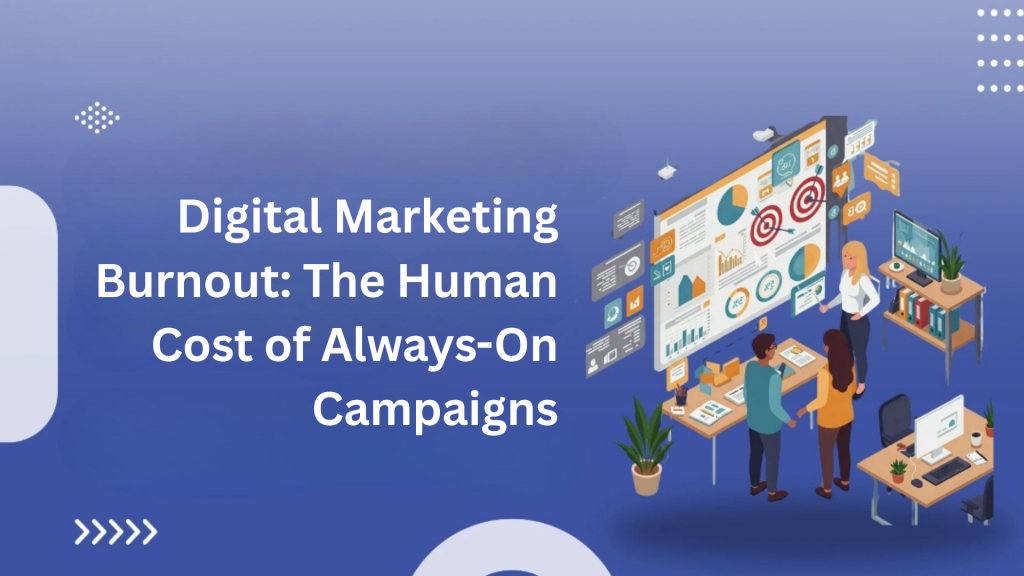The Rise of the “Always-On” Marketing Culture –
In today’s digital-first business landscape, marketing teams are expected to perform around the clock. From launching campaigns at odd hours to responding instantly on social media, digital marketers are always “on.” This shift has created an environment where speed, responsiveness, and performance are prioritized over well-being. What once felt like creative, strategic work is now a race against algorithms, KPIs, and deadlines.
The pressure to be present 24/7 comes from all directions—clients, stakeholders, even consumers who expect brands to respond in real-time. With the rapid evolution of platforms like Instagram, LinkedIn, TikTok, and Google Ads, marketers must constantly adapt, relearn, and realign. The outcome is clear: many professionals in digital marketing are burning out, and the industry has yet to address it seriously.
The Hidden Stressors Behind the Screen –
While digital marketing may appear glamorous on the surface—trending content, viral campaigns, sleek reports—the reality behind the scenes is often different. Marketers juggle multiple campaigns, unpredictable algorithms, demanding clients, and ever-changing tools. There’s little room for downtime. Campaigns are monitored late at night, content is created on weekends, and responses are expected within minutes.
What makes it worse is the lack of off-seasons. Unlike traditional industries with predictable peaks, digital marketing is always active. New product launches, festive campaigns, flash sales, and quarterly goals keep the engine running nonstop. These overlapping responsibilities and the expectation to stay “plugged in” all the time can cause serious mental and emotional strain.
Common Stressors Include:
- Multitasking across SEO, content, PPC, social media, email marketing, and analytics
- Pressure to deliver ROI in real time or “go viral”
- Sudden platform changes (e.g., algorithm updates, ad policy changes)
- High-volume reporting and data analysis expectations
Real-World Impact: Burnout is More Than Just Fatigue –
Burnout in digital marketing isn’t just about being tired—it’s a state of chronic physical and mental exhaustion. Professionals experiencing burnout often report losing passion for the work they once loved. They feel emotionally drained, struggle to focus, and may even experience anxiety or depression. This is especially common in startups and agencies, where small teams handle large workloads and tight deadlines.
Real-life stories reinforce this trend. Social media managers talk about needing to respond to comments at midnight. Content strategists mention writing under extreme time pressure. Performance marketers are expected to generate leads daily or face scrutiny. Many eventually quit the industry or shift to less demanding roles, causing a loss of talent and institutional knowledge.
Signs of Burnout in Marketers:
- Constant fatigue, even after rest
- Loss of motivation or creativity
- Feeling overwhelmed or “numb” at work
- Anxiety around client communication or campaign launches
The Culture Problem: Hustle Over Health –
Digital marketing has long been fueled by hustle culture. “Always grinding,” “never sleep,” and “outwork the competition” are common mantras in the industry. While ambition is valuable, glorifying non-stop work creates toxic environments. Junior marketers are often pushed to mimic unhealthy work patterns set by leaders who equate long hours with dedication. Unfortunately, this mindset ignores the psychological toll it takes.
The fear of being replaced or falling behind in an ultra-competitive job market forces many to stay silent about their struggles. Remote work, which exploded after the pandemic, added more complexity—making it even harder to draw the line between personal and professional time. When the laptop is always nearby, so is the pressure to work.
Toxic Mindsets That Contribute to Burnout:
- Equating success with being “online” all the time
- Celebrating team members who work nights and weekends
- Ignoring mental health conversations at work
Solutions: Creating a Sustainable Digital Marketing Culture –
Addressing burnout in digital marketing isn’t just a personal responsibility—it’s a leadership issue. Employers, managers, and clients must work together to build a culture that values long-term well-being over short-term gains. This includes setting realistic expectations, allocating enough resources, and encouraging teams to disconnect after hours.
Technology should be an enabler, not a burden. Automation, scheduling tools, and analytics dashboards can reduce manual effort and improve work-life balance. Equally important is building psychological safety—where marketers can talk about challenges without fear of being judged. Organizations that adopt these practices often see better retention, stronger performance, and more creative output.
Steps to Reduce Burnout in Digital Marketing:
- Set clear work boundaries (no weekend messages or late-night reports)
- Automate campaign tasks and reporting wherever possible
- Offer mental health days, flexible hours, and wellness programs
- Invest in training to improve efficiency and reduce rework
Conclusion –
Digital marketing is one of the most dynamic and exciting fields today. But it’s also one of the most demanding. As technology evolves, so must our approach to managing the people behind it. Burnout is not a badge of honor—it’s a warning sign. If we continue to normalize the “always-on” mentality, we risk losing creativity, empathy, and talent in the long run.
It’s time to rethink the way we structure campaigns, measure performance, and define success. True growth doesn’t come from overworking marketers—it comes from empowering them. Let’s create a culture that doesn’t just drive results, but also supports the people who make those results possible.

